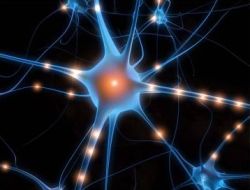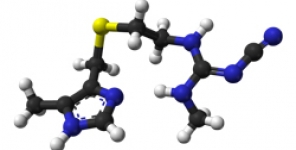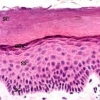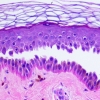Un confronto dell'espressione di neuropeptidi nella pelle con dermatite allergica da contatto, nell'uomo e nel topo
 La dermatite allergica da contatto (ACD) è una manifestazione della risposta immune cellulo-mediata, ma il suo meccanismo resta tuttora sconosciuto. Recentemente, abbiamo studiato come ACD coinvolge i vari neuropeptidi . La sostanza P (SP) è un neuropeptide noto per agire come recettore della neurochinina quando viene avviata la risposta immunitaria. Il peptide correlato al gene della calcitonina (CGRP) è un tipico neuropeptide, che induce la risposta immunitaria insieme ad SP. I neuropeptidi nell'infiammazione neurogenica sono regolati dall'inattivazione dei recettori e degli enzimi che possono causare la degradazione del neuropeptide (ad esempio l'enzima di conversione dell'angiotensina [ACE]), ma non è stato ancora segnalato un enzima in grado di degradare SP e CGRP.
La dermatite allergica da contatto (ACD) è una manifestazione della risposta immune cellulo-mediata, ma il suo meccanismo resta tuttora sconosciuto. Recentemente, abbiamo studiato come ACD coinvolge i vari neuropeptidi . La sostanza P (SP) è un neuropeptide noto per agire come recettore della neurochinina quando viene avviata la risposta immunitaria. Il peptide correlato al gene della calcitonina (CGRP) è un tipico neuropeptide, che induce la risposta immunitaria insieme ad SP. I neuropeptidi nell'infiammazione neurogenica sono regolati dall'inattivazione dei recettori e degli enzimi che possono causare la degradazione del neuropeptide (ad esempio l'enzima di conversione dell'angiotensina [ACE]), ma non è stato ancora segnalato un enzima in grado di degradare SP e CGRP.
Metodi: Abbiamo studiato i cambiamenti nell'espressione di SP e CGRP, come rappresentanti dei neuropeptidi più comuni nella pelle umana e di topo con ACD, e l'effetto dell'espressione di ACE sulla degradazione di questi neuropeptidi, utilizzando la reazione a catena della polimerasi trascrittasi inversa e il saggio immunoblot. Abbiamo anche esaminato la relazione tra ACD e i neuropeptidi nel tessuto cutaneo proveniente da soggetti umani con ACD e da topi con ACD indotta attraverso l'analisi dell'espressione delle citochine, i risultati della colorazione ad ematossilina-eosina e il saggio di immunofluorescenza.
Risultati: L'espressione di SP, CGRP, e ACE è stata più alta nei tessuti cutanei provenienti da animali con ACD acuta rispetto alla pelle da animali normali. Tuttavia, l'espressione di CGRP nella pelle di soggetti umani con ACD acuta è stata inferiore rispetto alla pelle normale, a differenza dell'espressione di SP e ACE, che sono stati entrambi più alti nella pelle umana con ACD rispetto alla pelle umana normale.
Conclusioni: Abbiamo trovato diversi modelli di espressione dei neuropeptidi nella pelle umana rispetto a quella del topo. Queste attività dei neuropeptidi sono state influenzate da un incremento degli enzimi degradativi dei neuropeptidi stessi. I nostri risultati mostrano che quando SP è prodotto, l'espressione di CGRP viene soppressa nella pelle umana di soggetti con ACD. La riduzione dell'espressione di CGRP nei pazienti con ACD acuta è causata dai mastociti attivati da SP.
Storia della pubblicazione:
Titolo: A comparison of neuropeptide expression in skin with allergic contact dermatitis in human and mouse
Rivista: International Journal of Dermatology. doi: 10.1111/j.1365-4632.2011.05197.x
Autori: Yun Young Lim, Hyeong Mi Kim, Hye In Lee, Seog-Kyun Mun, Chan Woong Kim, Myeung Nam Kim, Beom Joon Kim.
Affiliazioni: Department of Dermatology, College of Medicine, Chung-Ang University, Seoul, South Korea
Department of Otorhinolaryngology, Chung-Ang University Hospital, Seoul, South Korea
Department of Emergency Medicine, Chung-Ang University Hospital, Seoul, South Korea
Abstract:
Background Allergic contact dermatitis (ACD) is a manifestation of a cell-mediated immune response, but its mechanism remains unknown. Recently, we investigated whether ACD involves various neuropeptides. Substance P (SP) is a neuropeptide that is known to act as a neurokinin receptor when the immune response is initiated. Calcitonin gene-related peptide (CGRP) is a distinct typical neuropeptide and, with SP, induces the immune response. Neuropeptides in neurogenic inflammation are regulated by the inactivation of receptors and enzymes that can cause neuropeptide degradation (e.g. angiotensin-converting enzyme [ACE]), but no enzyme that can degrade SP and CGRP has yet been reported.
Methods We investigated changes in the expression of SP and CGRP, as representative of typical neuropeptides, in ACD skin in mouse and human and the effect of ACE expression on the degradation of these neuropeptides using reverse transcription polymerase chain reaction and immunoblot assay. We also examined the relationship between ACD and neuropeptides in skin tissue from human ACD subjects and mice with induced ACD by analyzing cytokine expression and the results of hematoxylin and eosin staining and immunofluorescence assay.
Results Expression of SP, CGRP, and ACE was higher in skin tissues from animals with acute ACD than in normal animal skin. However, CGRP expression in human skin with acute ACD was lower than in normal skin, unlike expression of SP and ACE, both of which were higher in ACD human skin than in normal human skin.
Conclusions We found different patterns of neuropeptide expression in human versus mouse skin. These neuropeptide activities were influenced by an increase in neuropeptide degrading enzymes. Our findings show that when SP is produced, expression of CGRP is suppressed in human skin with ACD. The reduction of CGRP expression in patients with acute ACD is caused by mast cells activated by SP.





